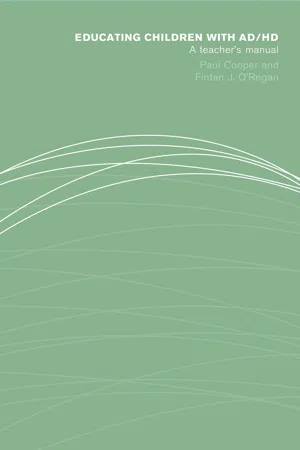![]()
Part 1:
Understanding AD/HD
This opening part of the book deals with the nature of AD/HD in terms of its origins, and the biological, psychological and social influences on its development.
![]()
1
AD/HD
What it is, and what it isn’t
AD/HD DEFINED
The term Attention Deficit/Hyperactivity Disorder originates from the fourth edition of the Diagnostic and Statistical Manual of the American Psychiatric Association (APA, 1994). This is the most recent version of the diagnosis which has gone through many changes since a biologically based problem of inattentiveness and overactivity was first proposed by the English paediatrician George Still in 1902 (Still, 1902). It should be noted that there is a similar diagnostic criterion published by the World Health Organisation (1990) referring to a condition known as ‘Hyperkinetic Disorder’ (HD). Although there are important technical differences between the two criteria, from the teacher’s viewpoint the two diagnoses can be treated as identical. This book will refer throughout to the American version of the diagnosis since, at the time of writing, it is the one that teachers are most likely to encounter. (See Appendix 1 for a note on similarities and differences between the two diagnostic criteria.)
Key Features of AD/HD
Key features of the AD/HD diagnosis are inattention, hyperactivity and impulsivity. These can be defined more fully in terms of children who display some of the following behavioural characteristics, based on the APA diagnostic criteria (APA, 1994).
Inattention
• often fails to give close attention to details or makes careless mistakes in school-work, work, or other activities
• often has difficulty sustaining attention to tasks or play activities
• is easily distracted from tasks and play activities
• often does not seem to listen when spoken to directly
• often does not follow through on instructions and fails to finish schoolwork, jobs, or duties in the workplace (not due to oppositional behaviour or failure to understand instructions)
• often has difficulty organising tasks and activities
• often avoids, dislikes or is reluctant to engage in tasks that require sustained mental effort (such as schoolwork or homework)
• often loses things necessary for tasks or activities (e.g. toys, schoolwork, pencils, books or tools)
• is often forgetful in daily activities
Hyperactivity/Impulsivity (1) Hyperactivity
• often fidgets with hands or feet or squirms in seat
• leaves seat in classroom or in other situations in which remaining seated is expected
• often runs about or climbs excessively in situations in which it is inappropriate (in adolescents and adults this aspect may be limited to subjective feelings of restlessness)
• often has difficulty in playing or engaging in leisure activities quietly
• is often ‘on the go’ or often acts as if driven by a motor
• often talks excessively
(2) Impulsivity
• often blurts out answers before questions have been completed
• often has difficulty awaiting turn
• often interrupts or intrudes on others (e.g. butts into conversations or games)
Sub-Types
There are three main ways in which AD/HD manifests itself:
1. The mainly hyperactive sub-type
2. The mainly inattentive sub-type
3. The combined sub-type (both hyperactive and inattentive)
This highlights the fact that not all people with AD/HD are overactive or behaviourally disruptive. Individuals with the mainly inattentive form of AD/HD, far from being intrusive, are often easily ignored and neglected.
simply behaving
in some or even all of these ways
does not mean
that a person has AD/HD
For the AD/HD diagnosis to be made, the diagnosing clinician (usually a paediatrician or child psychiatrist) must be satisfied that the following conditions have been met:
• the number and type of symptoms should be consistent with the conditions laid down in the diagnostic criteria, meaning that the child must display six or more of the symptoms from the inattention list, or six or more from the hyperactivity/impulsivity lists
• the problems must have persisted for at least six months to a degree that is maladaptive and inconsistent with the child’s developmental level
• there must be evidence that some of these symptoms were present before the age of 7 years
• problems are pervasive across two or more settings, e.g. at school (or work) and at home
• there must be clear evidence of clinically significant impairment in social, academic or occupational functioning (i.e. the symptoms must interfere significantly with the individual’s emotional, educational, or professional functioning)
• the symptoms are not directly related to a Pervasive Developmental Disorder, Schizophrenia or other Psychotic Disorder, and are not better accounted for by another mental disorder (as described the DSM IV, e.g. Mood Disorder, Anxiety Disorder, Dissociative Disorder or a Personality Disorder).
PSEUDO AD/HD: WHAT LOOKS LIKE AD/HD, BUT ISN’T AD/HD?
Clearly, every one of us at some times displays some or all of these characteristics. In most mainstream school classrooms, most children will at some time be inattentive, impulsive or overactive. A few children will have all of these behaviours in their repertoires. Most people when they are tired, bored or under pressure will not be able to concentrate as well as they usually can and may be easily distracted. Some people, when they are excited, bored or anxious may act impulsively, become fidgety or restless. Children may display some or all of these behaviours when they are physically ill or otherwise stressed, for example, as a result of personal problems, family trauma or because they are anxious or disturbed by something.
If the behaviours of concern can be directly associated with external stressors, then before the possibility of AD/HD is considered efforts must be made to remove these stressors, or, where appropriate, help the affected individual to learn effective ways of dealing with the stressors. If the behavioural difficulties are directly the result of external problems then it is unlikely th...

